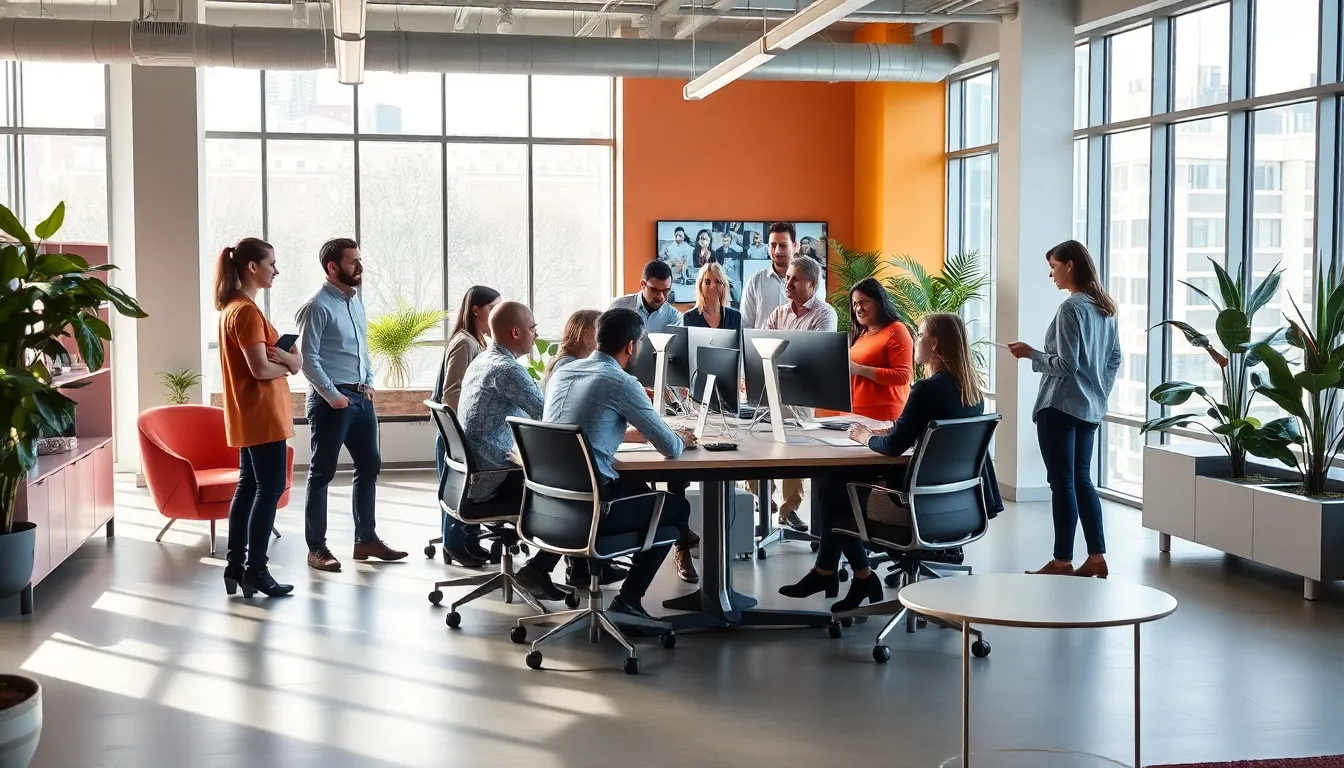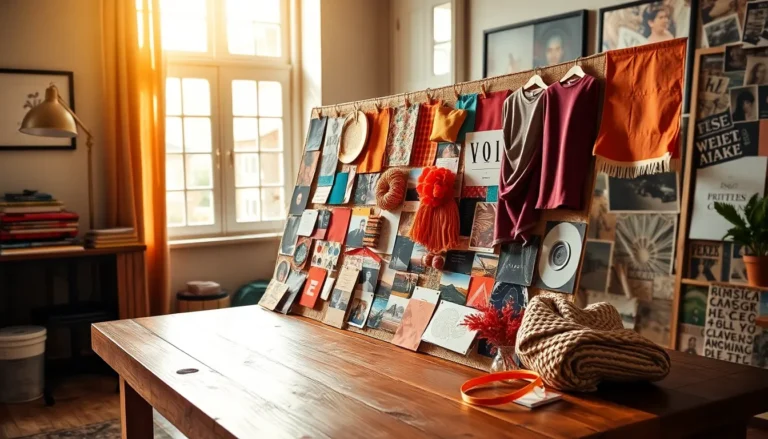Table of Contents
ToggleIn today’s world, effective space planning is more crucial than ever. Whether designing a cozy home or a dynamic office, the way space is organized can significantly impact functionality and aesthetics. It’s not just about fitting furniture into a room; it’s about creating an environment that enhances productivity and comfort.
Understanding the principles of space planning allows individuals and businesses to maximize their available areas while ensuring a seamless flow. Thoughtful layouts can transform ordinary spaces into extraordinary experiences, making them not only visually appealing but also practical. As the demand for innovative design continues to grow, mastering space planning becomes essential for anyone looking to optimize their surroundings.
What Is Space Planning?
Space planning refers to the strategic arrangement of physical space to optimize functionality and aesthetics. It involves analyzing how individuals or groups interact with their environment in both residential and commercial settings. Professionals utilize space planning to create layouts that enhance accessibility and traffic flow while ensuring efficient usage of available space.
Space planning encompasses several key elements:
- Functionality
Functionality focuses on serving the specific needs of users. It identifies how different areas or rooms will be utilized, allowing for tailored arrangements that support activities and promote productivity.
- Ergonomics
Ergonomics ensures that spaces accommodate the physical needs of users. Properly designed spaces reduce the risk of injury and enhance comfort, contributing to overall well-being.
- Aesthetics
Aesthetics play a crucial role in creating visually appealing environments. Space planning integrates color, texture, and style to achieve harmony and enhance user experience.
- Flexibility
Flexibility allows spaces to adapt to changing needs over time. Incorporating movable furniture or convertible spaces can accommodate various functions, making areas more versatile.
- Compliance
Compliance with building codes and regulations ensures safety and legality. Understanding these requirements is essential for effective space planning.
By applying these principles, effective space planning fosters environments that support both individual and communal activities, driving engagement and satisfaction.
Importance Of Space Planning

Effective space planning is crucial for optimizing both functionality and aesthetic appeal in any environment. It contributes significantly to overall satisfaction and effectiveness in residential and commercial spaces.
Maximizing Efficiency
Maximizing efficiency stems from thoughtful space planning. Efficient layouts enable smooth movement and interaction. Optimized workstations accommodate necessary tasks, reducing wasted time and effort. Strategic placement of furniture enhances productivity by promoting collaboration while ensuring privacy where needed. Multi-functional spaces can serve various purposes, accommodating diverse activities without clutter. Ultimately, efficient space planning minimizes disruptions and maximizes the use of available resources.
Enhancing Aesthetic Appeal
Enhancing aesthetic appeal is another fundamental aspect of space planning. Carefully integrated design elements improve visual harmony. Color schemes, textures, and materials create cohesive environments that reflect desired styles. Art and décor enrich spaces, adding character and interest. Balanced proportions and clear sightlines contribute to an inviting atmosphere. Well-designed areas resonate with users, fostering emotional connections and improving their overall experience. Aesthetic appeal, paired with functionality, transforms everyday environments into inspiring spaces.
Key Principles Of Space Planning
Effective space planning hinges on understanding and addressing the diverse requirements of users while ensuring functionality throughout the environment. The following principles highlight critical aspects of successful space planning.
Understanding User Needs
Understanding user needs is fundamental for creating spaces that enhance experience and interaction. Identifying distinct user activities informs layout decisions, such as work habits, preferences, and accessibility requirements. Surveys and interviews can gather valuable insights, while observational studies assess how users interact with their surroundings. Prioritizing user input promotes engagement and satisfaction in both residential and commercial environments.
Considering Functionality
Considering functionality involves analyzing how spaces serve their intended purposes. Evaluating layouts for workflow efficiency minimizes unnecessary movement and maximizes productivity. Proximity to essential resources, like equipment or storage, simplifies tasks. Adapting space configurations to support various activities ensures versatility, whether for collaborative work or focused tasks. Effective functional space planning optimizes usage, creating environments that foster both capability and comfort.
Space Planning Tools And Techniques
Effective space planning relies on a mix of software solutions and manual methods to create optimal layouts that meet specific needs. Utilizing these tools enhances both functionality and aesthetics in various environments.
Software Solutions
Many software solutions simplify space planning by providing design visualization and layout tools. Popular options include:
- AutoCAD: This industry-standard software offers precise drawing and drafting capabilities, enabling detailed floor plans and layouts.
- SketchUp: A user-friendly 3D modeling tool allows for easy visualization of spaces and the application of different design elements.
- RoomSketcher: This web-based solution facilitates quick creation of floor plans and 3D visualizations, ideal for residential and commercial projects.
- SmartDraw: This versatile diagram software supports space planning with templates and tools that simplify flowchart and layout creation.
These software applications enable users to experiment with layouts and designs, facilitating decision-making through visual representation.
Manual Methods
Despite advancements in technology, manual methods retain significant value in space planning. Key manual techniques include:
- Sketching: Drawing preliminary layouts on paper allows for spontaneity and exploration of ideas before committing to digital formats.
- Cutouts: Using small cardboard cutouts to represent furniture and fixtures aids in visualizing spatial relationships and flow within a layout.
- Tape Measurements: Physically measuring spaces with tape provides an accurate understanding of dimensions and spatial constraints.
- Grid Paper: Utilizing grid paper for sketching layouts helps maintain scale, ensuring objects are proportionate and properly aligned.
These manual techniques foster hands-on interaction with the space, encouraging creativity and practicality in planning efforts.
Challenges In Space Planning
Space planning presents various challenges that can hinder the creation of efficient and aesthetically pleasing designs. Addressing these obstacles effectively contributes to optimized functionality and improved user experiences.
Common Obstacles
- Limited Space: Smaller areas restrict layout options, making optimizing functionality complicated. Creative solutions are necessary to make the most of every square foot.
- User Needs Variability: Different users may have distinct needs, and accommodating these can complicate space planning. Understanding behavioral patterns and preferences is essential for effective design.
- Budget Constraints: Financial limitations can restrict design possibilities, influencing material choices and layout options. Strategic prioritization assists in maximizing the budget impact.
- Regulatory Compliance: Adhering to building codes and regulations can introduce challenges. Familiarity with local codes ensures space plans meet safety and legal requirements.
- Technological Limitations: Not all tools offer comprehensive features for complex layouts. Evaluating software tools can determine the best fit for specific space planning needs.
Solutions And Best Practices
- Conduct Thorough Assessments: Analyze user behaviors and traffic patterns to inform efficient space layouts. Regular surveys gather insights for a more tailored approach.
- Prioritize Flexibility: Design layouts that accommodate changing needs. Modular furniture and multifunctional spaces enhance adaptability, ensuring longevity in design.
- Utilize Advanced Tools: Employ software that offers visualization and simulation features. Tools like AutoCAD and SketchUp allow for testing different layouts before implementation.
- Engage Stakeholders: Involve end-users during the planning phase to ensure designs meet their needs. Collaboration fosters acceptance and satisfaction with the final product.
- Plan for Growth: Anticipate future needs and trends when designing spaces. Incorporating scalable solutions ensures readiness for any expansions or shifts in usage.
Mastering space planning is essential for anyone looking to create functional and aesthetically pleasing environments. By leveraging key principles and tools, individuals and businesses can transform their spaces into areas that promote productivity and comfort.
Addressing challenges like limited space and varying user needs becomes more manageable with a thoughtful approach to design. This proactive strategy not only enhances the user experience but also ensures that spaces remain adaptable for future demands.
Ultimately, effective space planning is about understanding how people interact with their surroundings and making informed decisions that elevate everyday environments. It’s a crucial investment that pays off in satisfaction and efficiency.




